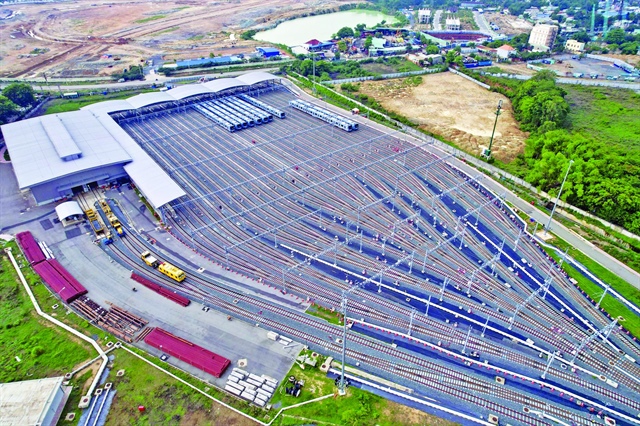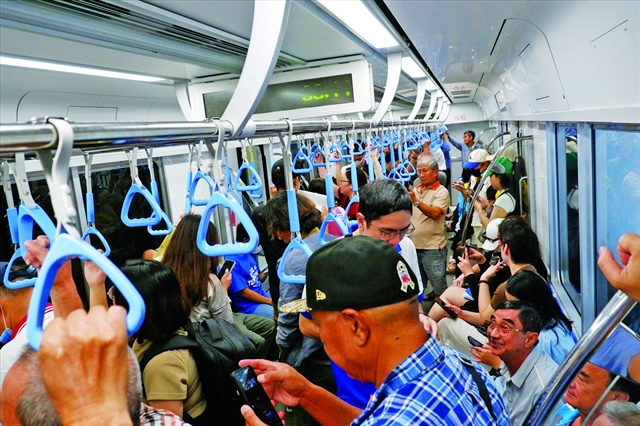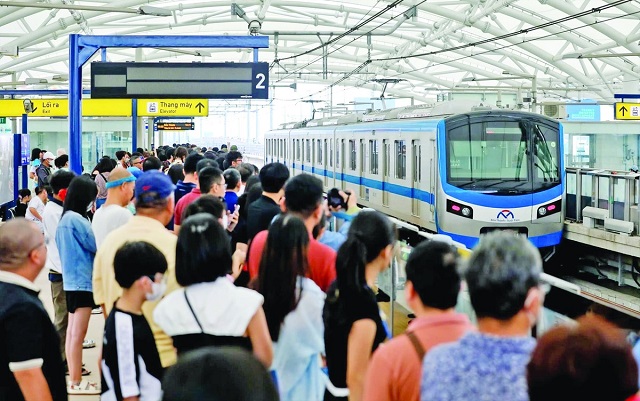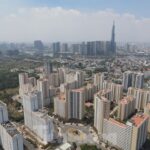
The Long Binh depot of Ho Chi Minh City’s Metro Line 1. Photo: Duy Anh |
After 12 years of construction, Ho Chi Minh City’s first urban railway, the Metro Line 1 (Bến Thành – Suối Tiên), was completed and officially operated from the end of December 2024.
According to the Ho Chi Minh City Urban Railway Management Board No. 1 (HURC1, the operator), after more than 3 months of commercial operation, Metro Line 1 has operated 15,324 train trips with an average of 348 passengers/trip, and the total number of passengers has reached more than 5.3 million.
“Metro Line 1 has been well received by the people. The number of passengers exceeded expectations, which is a positive sign and a good sign for public transport in the coming time,” said Mr. Le Minh Triet, Director of HURC1.
Straining with 355km of metro
Mr. Tran Quang Lam, Director of the Ho Chi Minh City Department of Transport, said that since the operation of Metro Line 1, public transport in the city has changed positively.
In the first quarter of 2025, travel by public transport in the city increased by nearly 7% over the same period last year. “From Metro Line 1, the city’s transport industry has switched to using clean-fuel buses (green buses). Thereby, it has changed the face and quality of service. Now, the trend of people switching from personal vehicles to using public transport is becoming more and more clear,” said Mr. Lam. He said that along with the positive changes in public transport, strict regulations on traffic rules have also contributed to ensuring traffic order and safety, reducing 3 criteria (reducing the number of accidents, the number of deaths, and the number of injuries).
According to Mr. Lam, in the next 10 years, the city will complete the Ring Roads 2, 3 and 4, the project to expand national highways (National Highway 1, National Highway 13, National Highway 22, North-South Road, etc.). Thereby, basically solving urban transport infrastructure. However, to reduce traffic congestion, it is necessary to develop a public transport system and move to the next phase of reducing private vehicles. “Ho Chi Minh City has proposed and the National Assembly has passed Resolution 188 – with special policies to remove obstacles in investment. This will be the key to the city completing 355km of urban railways in the next 10 years – an important milestone in modernizing the transport system, reducing dependence on private vehicles and towards a green, smart and sustainable city,” said Mr. Lam.
|
Architect Ngo Viet Nam Son said that the implementation of Metro Line 1 encountered many difficulties due to many stages being prolonged, especially in the process of requesting directions and organizing the implementation. From this reality, Ho Chi Minh City needs to draw experiences and apply them to the following projects. It is necessary to prepare clean land before construction to avoid affecting the construction progress and incurring additional costs. In addition, building a metro is not simply constructing a transport route, but it is also closely related to urban underground planning, landscape, commercial services, and tourism activities, so it requires coordination between industries. A key factor in ensuring progress is to improve the legal mechanism, limit the “ask-give” situation, and shorten administrative procedures to promote the implementation of the project according to the plan. |
According to calculations, Ho Chi Minh City needs to mobilize about 40.2 billion USD to invest in 355km of urban railways in 10 years. To do this, Resolution 188 of the National Assembly also has mechanisms to help Ho Chi Minh City mobilize all resources. However, the huge investment capital, land clearance, and construction capacity are still challenges that need to be solved.
Mr. Phan Cong Bang, Head of the Ho Chi Minh City Urban Railway Management Board, affirmed that completing 355km is a mandatory task. Resolution 188 of the National Assembly has created superior mechanisms, shortening the time by 3-4 years compared to the previous process. At the same time, the decentralization for Ho Chi Minh City to approve investment projects will speed up the progress. Especially, allowing the designation of consultants and contractors for construction; designation of contractors for urban railway projects associated with TOD (Transit-Oriented Development). Therefore, the progress of projects in the coming time will be shortened.
“These mechanisms help to shorten the time significantly. For example, in the past, after 5-7 years, the investment policy for Route 5 has not yet been approved. Traffic congestion often occurs in Ho Chi Minh City. After operating Route 1, it has proved the effectiveness of using the metro. Therefore, it is very urgent to complete the urban railway system,” said Mr. Bang.
According to Mr. Bang, Metro Line 2 (Ben Thanh – Tham Luong) is the first project to apply the special mechanism of Resolution 188. The project is expected to be inaugurated in 2030. Therefore, the current work is very urgent, such as project contracts, TOD exploitation, and technology used in Metro Line 2.
Regarding standards and technology of urban railway routes, Mr. Bang also said that they must be unified. Urban railways in Hanoi and Ho Chi Minh City must use the same technology to ensure operation later. According to the orientation, these urban railway routes will be implemented with European technology.
Regarding capital sources, Mr. Bang said that in the proposal to build a special mechanism, the sources of capital from the central and local budgets have been clearly identified. The central capital source has been balanced, and the roadmap for local capital sources includes investment capital sources, revenue from TOD, local bonds, etc. With new mechanisms and new ways of doing things, Ho Chi Minh City can complete 355 km of urban railways in the next 10 years.

Passengers on Ho Chi Minh City’s metro. Photo: Huu Huy |
The key to TOD
In the process of implementing the urban railway system in Ho Chi Minh City, the authorities pay attention to implementing the model of developing the city according to the orientation of developing public transport (TOD).
Mr. Nguyen Anh Tuan, Head of the Infrastructure Management Department, Ho Chi Minh City Department of Construction, said that promoting the development of the metro to 2030 and completing it by 2050 according to the TOD development model is very urgent. Developing the city according to the TOD model around large-scale public transport stations, supplementing infrastructure connecting regions, and connecting areas of Ho Chi Minh City now needs a strategy.
“The city can apply special mechanisms to collect and use 100% of the revenue in the TOD area to develop the urban railway system, the public transport system, and technical infrastructure connecting with the passenger transport system. The potential land fund for developing the TOD model in Ho Chi Minh City can reach 60,000 ha,” said Mr. Tuan.
Mr. Bui Xuan Cuong, Vice Chairman of the Ho Chi Minh City People’s Committee, said that the development of TOD aims to promote the process of green and sustainable growth for Ho Chi Minh City and the whole region. Ho Chi Minh City has planned many locations to develop TOD. In the period of 2024-2028, the city will develop the city according to the TOD model in 11 areas along Metro Line 1, Metro Line 2, and Ring Road 3 in Ho Chi Minh City.
Regarding the story of TOD development, according to Mr. Le Hoang Chau, Chairman of the Ho Chi Minh City Real Estate Association, each metro line has a central station, a head station, and an end station, and the scale also has large, medium, and small stations. Depending on each metro station, there must be integrated planning to develop the city in that area, which is called the “golden radius” by the world. Metro stations in other countries go through densely populated residential areas, close to industrial parks and large tourist areas to promote the large capacity of this type of transport. “Countries around the world use land funds around metro stations in the ‘golden radius’ to develop commercial, service, production, social housing, and commercial housing projects at affordable prices. At the same time, develop the metro to areas that are planned to develop new urban areas and are often called new investment destinations,” Mr. Chau said.

Passengers waiting for the Ho Chi Minh City metro. Photo: Duy Anh
|
|
By 2035, Ho Chi Minh City will have to complete 7 metro routes with a total length of 355km, including: Route 1 (Ben Thanh – An Ha section); Route 2 (Ben Thanh – Thu Thiem and Tham Luong – Cu Chi sections); Route 3 (Hiep Binh Phuoc – Binh Tri Dong – Cong Hoa Intersection – Tan Kien – An Ha); Route 4 (Dong Thanh – Tan Son Nhat Airport – Ben Thanh – Nguyen Huu Tho – Hiep Phuoc Urban Area); Route 5 (Long Truong – Hanoi Highway – Saigon Bridge – Bay Hien Intersection – Da Phuoc Depot); Route 6 (Inner Ring Road) and Route 7 (Tan Kien – Nguyen Van Linh Road – Thu Thiem – Thao Dien – Thanh Da – Hi-tech Park – Vinhomes Grand Park). |
According to Mr. Chau, in recent years, real estate enterprises have closely followed the transport development planning. For example, along Metro Line 1 in Ho Chi Minh City, since the construction, there have been many real estate projects along the metro route, especially at the stations. “There are very high-end real estate projects at Ba Son and Tan Cang stations. On the other side of Saigon Bridge, there are Thao Dien, An Phu, and Binh Thai stations, where there are projects that have been implemented by real estate investors for many years. Now, people living in these projects are benefiting. But because in the past, we did not have synchronous planning for metro stations, we have not been able to promote the form of TOD. Therefore, the State has not received much benefit from TOD,” said Mr. Chau.
Mr. Chau expects that Ho Chi Minh City’s development of 7 metro routes in the next 10 years is a potential for real estate enterprises to accompany. Thereby, towards the goal of benefiting the State, the people, and enterprises.
Architect Ngo Viet Nam Son said that to optimize the land fund around the stations and attract investment, Ho Chi Minh City needs to have a clear land use policy. It is necessary to determine the location, boundaries, and area of land to be recovered according to regulations, organize auctions to create capital for the metro.
In addition, if land is not revoked, there must also be a mechanism to collect value-added tax from land price increases after the metro is put into operation, thereby creating resources for reinvestment.

Rach Chiec station in the eastern gateway of Ho Chi Minh City. Photo: Huu Huy |
Huu Huy
– 08:20 05/03/2025
Should You Invest in Real Estate Amidst the Proposed Merger of Ho Chi Minh City, Binh Duong, and Ba Ria – Vung Tau?
The proposed merger of Ho Chi Minh City with Binh Duong and Ba Ria – Vung Tau provinces offers a unique opportunity to reshape the urban landscape and infrastructure of the region. This ambitious plan presents a blank canvas for innovative planning decisions and the potential to create thriving new communities. However, with great opportunity comes potential risk, especially for new investors entering the real estate market during this transformative phase.
Unveiling the Reasons Behind Northern Real Estate Investors’ Move Southward
“Savvy real estate investors with an eye for opportunity are turning their attention to the southern market, particularly the vibrant East region. Among the myriad of options, Izumi City stands out as a prime investment prospect. Strategically located and backed by a reputable developer, Izumi City offers a compelling proposition with its strong growth potential.”
The Great Detached Home – Villa Conundrum: An Unexpected Twist
“David Jackson, CEO of Avison Young, recently shared his insights on the future supply of villas and townhouses in Ho Chi Minh City. He emphasized that the majority of upcoming developments in these segments will be concentrated in the city’s satellite towns. This centrifugal direction is set to be the leading trend, shaping the real estate market.”





















